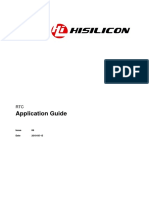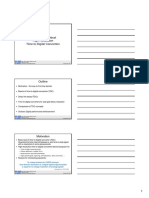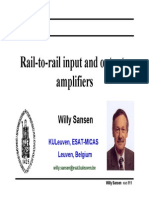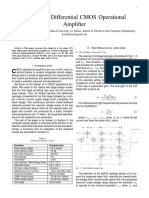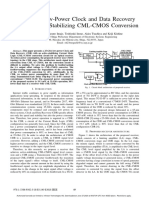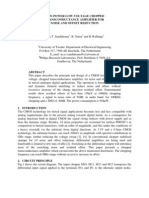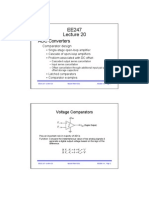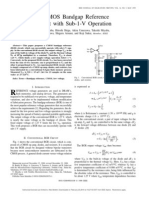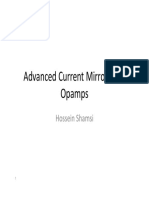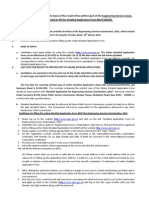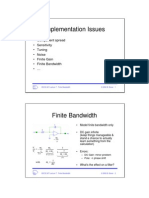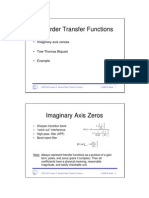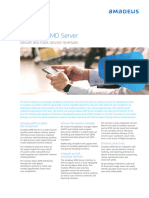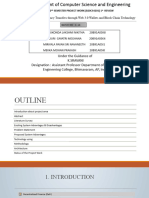EECS 247 Analog-Digital Interface Integrated Circuits 2002 Bernhard E.
Boser
Department of Electrical Engineering and Computer Sciences
A/D DSP
EECS 247 Lecture 1: Overview
2002 B. Boser 1
Administrative
Course web page: http://www.eecs.berkeley.edu/~boser (link to EECS 247) Overview
Scope of course Reference texts Grade and homework policy
Office hours
Tuesday 2 to 3pm Friday 11am to noon
A/D DSP
EECS 247 Lecture 1: Overview
2002 B. Boser 2
�Acknowledgement
Introduction to System Design and Modeling course, developed by Eric Swanson Notes from Prof. Gray for an earlier version of this course Countless books and articles
A/D DSP
EECS 247 Lecture 1: Overview
2002 B. Boser 3
Analog-Digital Interface Circuits
Anatomy of analog processor
analog pre/post processing A/D and D/A converters digital signal processor
Analog Input
Analog Preprocessing A/D Conversion DSP D/A Conversion Analog Postprocessing
Analog Output
A/D DSP
EECS 247 Lecture 1: Overview
2002 B. Boser 4
�Why Digital Processing?
Digital circuitry:
Cost/function decreases by 29% each year Thats 30X in 10 years
Analog circuitry:
Cost/function is constant Dropping supply voltages threaten feasibility
Transition to DSP is inevitable!
Ref: International Technology Roadmap for Semiconductors, http://public.itrs.net
EECS 247 Lecture 1: Overview 2002 B. Boser 5
A/D DSP
Why Analog Processing?
The real or physical world is analog Examples:
Digital Audio RF receiver Wireline communications
A/D DSP
EECS 247 Lecture 1: Overview
2002 B. Boser 6
�Example: Digital Audio
Goal
Lossless archival and transmission of audio signals
Analog Input
Circuit functions:
Preprocessing
Amplification Anti-alias filtering
Analog Preprocessing A/D Conversion DSP D/A Conversion Analog Postprocessing
Analog Output
A/D Conversion
>16Bits, >41kHz
DSP
Storage Processing (e.g. recognition)
D/A Conversion Postprocessing
Smoothing Amplification
A/D DSP
EECS 247 Lecture 1: Overview
2002 B. Boser 7
Example: RF Receiver
Goals
Wireless communication Minimizing use of bandwidth Immunity to interference
Analog Input
Analog Preprocessing A/D Conversion DSP D/A Conversion Analog Postprocessing
Analog Output
Circuit functions:
Preprocessing
Filtering Amplification Frequency translation
A/D Conversion DSP
Demodulation Decoding
D/A Conversion Postprocessing
Smooting Amplification
A/D DSP
EECS 247 Lecture 1: Overview
2002 B. Boser 8
�Example: Modem
Goals
Transmit data over inexpensive, noisy channel Maximize distance, minimize errors
Digital Clock and Data in
Circuit functions
Transmit DSP
Bandwidth efficient and error tolerant data encoding
Transmit DSP
Transmitter Noisy Channel Receiver
Transmitter
Pulse shaping (minimize ISI) Line driver
Noisy Channel
Frequency (and time) dependent attenuation Noise
Receiver
Equalization Clock recovery, slicing Receive DSP
Receive DSP
Decode data
A/D DSP
Digital Clock and Data out 2002 B. Boser 9
EECS 247 Lecture 1: Overview
Signal Processing Fundamentals
EECS 247
Filtering Data Conversion Data detection, timing recovery
EECS 142, 242
RF amplification, mixing Oscillators Nonlinear circuits
A/D DSP
EECS 247 Lecture 1: Overview
2002 B. Boser 10
�System Modeling
Top-down design
Abstraction Key for dealing with complexity (> 106 transistors) Each level establishes requirements for next level down in the hierarchy
Challenges
A/D DSP
Unrealizable blocks Physical constraints Modeling errors Number and complexity of blocks Verification
EECS 247 Lecture 1: Overview 2002 B. Boser 11
Challenge of IC Fabrication
No other EE discipline is less forgiving of errors
You can change PLDs or software in a day You can build and test a printed circuit board in a week It takes months to tape out and fabricate a chip Debugging and characterizing a (defective) chip also takes months
State-of-the-art chips are never perfect
But they have to be good enough for someone to buy them If you want to sell bugs, try a career in software (quote from Eric Swanson)
A/D DSP
EECS 247 Lecture 1: Overview
2002 B. Boser 12
�Modeling Tools
This is not a tool-centric course
Knowledge of design fundamentals lives through many generations of tools Behavioral modeling tools are not always effective: long learning curve
Tools we will use
MATLAB / Simulink (student version is adequate) SPICE MathCAD, Excel,
A/D DSP
EECS 247 Lecture 1: Overview
2002 B. Boser 13
EECS 247 versus 240
EECS 247
Macro-models, behavioral simulation, large systems Signal processing fundamentals High level of abstraction: physical constraints (e.g. finite gain, supply, noise) added where appropriate Matlab
EECS 240
Transistor level, building blocks Device and circuit fundamentals Little abstraction SPICE
A/D DSP
EECS 247 Lecture 1: Overview
2002 B. Boser 14








